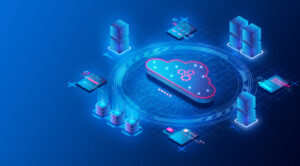
In one of our earlier blogs, we wrote about the importance of identifying the right cloud deployment model for your business. One approach companies are adopting is the “lift and shift” model of moving apps to the cloud and then figuring out how to upgrade them.
Once an application is moved to the cloud, it is often essential to reconfigure certain modules of the application and update data assets to ensure smooth deployment. However, in the case of some applications, it may be too complex to refactor code. These legacy or monolithic applications may have been built with a technology stack that is not ideal for the cloud. In such cases, the cloud migration effort fails, primarily because one is not able to take advantage of cloud-native features and functions.
In this blog, we explain what cloud-native applications are and also discuss five key aspects of cloud-native migrations.
What are Cloud-Native Applications?
Typically, cloud-native applications use a microservices-based architecture, wherein the overall application is developed as a collection of services. The technology stack is chosen so that each of the app components is scalable in containerised environments. This means that it is possible for developers to upgrade one component of the application or add new components – without affecting rest of the microservices.
By using a tool like Kubernetes, it is possible to automate the process of software deployment to the cloud – making the whole process of scaling and managing an application fairly simple. Kubernetes is a container orchestration system, that was first designed at Google but is now maintained by Cloud Native Computing Foundation (CNCF).
Key Aspects of Cloud Native Migrations
One of the biggest decisions to be made while migrating to the cloud is – which cloud platform should we move to. Should we go with AWS, Azure, or GCP?
A Merit expert adds, “Technology decision-makers also want to avoid cloud lock-in. They don’t want to be stuck with one cloud ecosystem. With a microservices-based architecture, it becomes easy to maintain and manage a truly hybrid cloud. Your analytics workloads can be on Amazon’s Redshift and Athena. For AI and ML, you may prefer GCP’s AutoML suite of tools. It is, therefore, critical that we build applications that are somewhat cloud-platform agnostic.”
The key components of cloud-native migrations include the following.
Serverless Computing
AWS Lambda and Google Cloud Functions are some of the most popular event-driven, serverless computing platforms. As code runs, the cloud provider is automatically able to figure out the storage and computing resources needed and allocate them accordingly.
As AWS experts say, with a service like Lambda one can build software and write code without worrying much about servers or clusters. Of course, they need to have a sense of costs, but overall serverless computing makes life easier for the IT team.
CI/CD framework
Jenkins, GitLab and GitHub Actions are some of the most popular CI/CD tools. CI/CD refers to the process of continuous development, testing and deployment of app components. In today’s world of rapid change, it is critical for companies to embrace the idea of ongoing improvement when it comes to software applications. Your analytics and AI solutions cannot be static solution that’ll stay the same for a long period of time. In fact, companies today deploy new features into app every day.
According to data from a survey conducted by Cloud Native Computing Foundation (CNCF), 29% of the companies who responded deploy new components or features into the live environment every day.
Containers and Microservices
Most DevOps teams use container services in the production environment. And, Kubernetes is the most popular container orchestration tool in the market. In the GCP platform, Google Kubernetes Engine (GKE) makes it possible to turn on auto-scaling and multi-cluster support. There are equivalent tools in Azure and AWS platforms as well.
One of the biggest advantages of cloud-native applications is the elasticity of apps when it comes to workload management. For instance, let us say you’re the CIO of a large retail company. During a massive holiday season sale, the compute resources needed for your pricing algorithm, inventory management solution, and analytics engines may be far greater than what is needed at other times.
When the app is built from the ground up for the cloud, the IT team experiences the following advantages –
- Run code without worrying about provisioning/infrastructure management. This happens automatically with a service like AWS Lambda or equivalent.
- Code execution requests at scale are easy to manage. You may end up having tens of thousands of events per day and it’s easier to execute with cloud-native applications.
- By provisioning concurrence, it is possible to respond to one-off high-demand situations.
- Save costs by paying for the compute (and storage) resources you actually use. This elasticity of infrastructure is extremely handy for companies where the number of events (code execution requests) per day varies on a daily basis.
Merit’s Expertise in Cloud Migration Efforts
Merit works with a broad range of clients and industry sectors, designing and building bespoke applications and data platforms combining software engineering, AI/ML, and data analytics.
We migrate legacy systems with re-architecture and by refactoring them to contemporary technologies on modern cloud ecosystems. Our software engineers build resilient and scalable solutions with cloud services ranging from simple internal software systems to large-scale enterprise applications.
Our agile approach drives every stage of the customer journey; from planning to design development and implementation, delivering impactful and cost-effective digital transformations.
To know more, visit: https://www.meritdata-tech.com/service/code/digital-engineering-solutions/
Related Case Studies
-
01 /
A Digital Engineering Solution for High Volume Automotive Data Extraction
Automotive products required help to track millions of price points and specification details for a large range of vehicles.
-
02 /
Resolving Tech Staffing Challenges Through An Off-Shore Resourcing Model
Part of a 7.5 billion conglomerate, the client is a global B2B digital business information and analytics company that provides information-based analytics, decision tools and data services to their client
